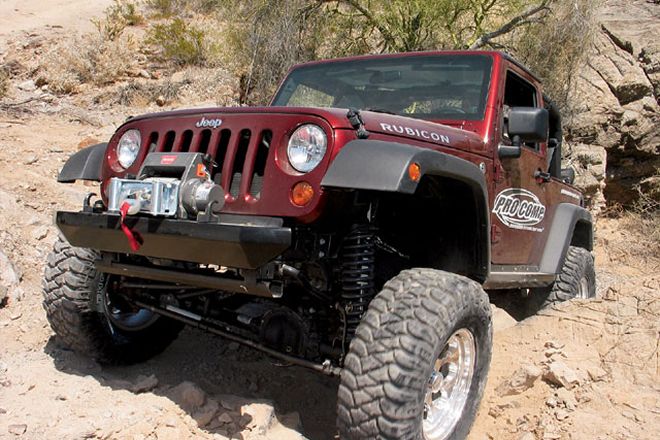
 Christian Hazel
Brand Manager, Four Wheeler
Christian Hazel
Brand Manager, Four Wheeler
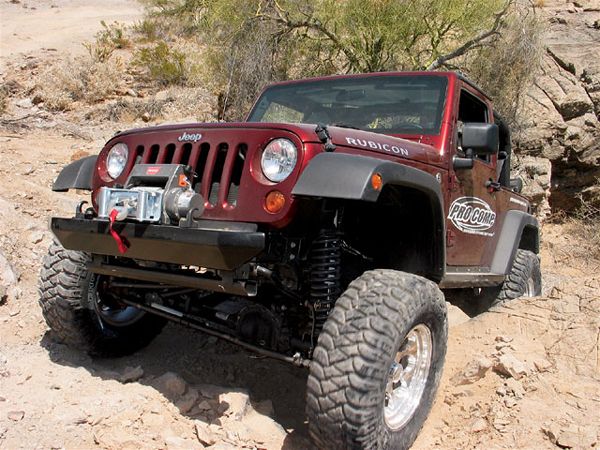
Recently, we got the nod to be a judge on our sister publication 4-Wheel & Off-Road's JK Wrangler Runaround. Apparently, 4WOR Feature Editor and all-around madman Jerrod Jones loves burning the candle at both ends because he set up the incredibly intensive three-day test. Jerrod invited every aftermarket suspension manufacturer to show up in the desert town of Parker, Arizona, with a two-door JK Wrangler. The Jeeps needed to be equipped with the respective company's 3-4-inch short-arm suspension, complete with replacement control arms, shocks, and any steering, brake, or other corrections the company may use. When the dust settled, eight manufacturers showed up. We then ran the Wranglers through a series of courses that had been prerun to extract as much information from the suspensions as possible.
Before the testing began, we put each Wrangler up on a lift to study its suspension. Then we hit a pavement course, a high-speed dirt course, a rockcrawling course, and a desert race whoops-strewn course. You won't get the whole story here, but we'll happily let you peek over our shoulder at Jp's judging book to get our impressions. For the whole story and to see how each suspension did when weighed against the rankings of all eight judges, we suggest you pick up the Sept. '07 issue of 4-Wheel & Off-Road magazine.
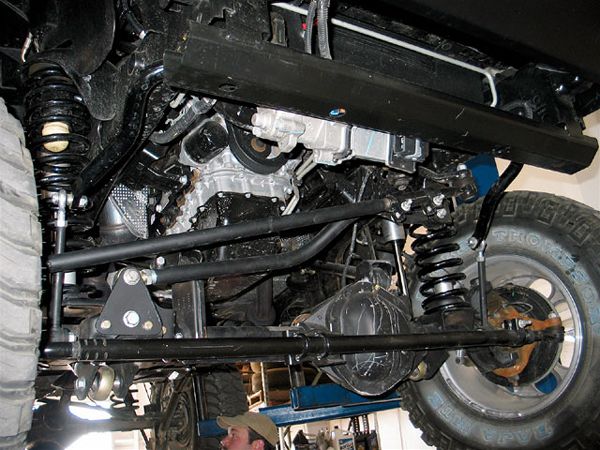
Donahoe Racing
The Donahoe Racing suspension system is truly one of the higher-end kits we've seen. With 12-point aerospace hardware, a unique control-arm cinch bolt design, nice welds, and high-quality rod ends, it left little to be desired. Add on the optional Donahoe Racing ZooRoad remote-reservoir 2.5-inch shocks, and this suspension isn't for the guy who just wants the look of bigger tires.
On the rack: With adjustable links capped with rod ends on each side, we wondered why the rear pinion angle wasn't rotated up to work with the rear CV. Perhaps a last-minute oversight? The rear brake lines were very taut with the rear axle under full droop. They need another 2 inches of length to make us happy. There is a raised track-bar bracket up front with no dropped pitman arm, but the angles don't seem too out of whack. Component quality and fit and finish are of the highest degree, but the install looks moderately involved for the average do-it-yourselfer.
On the street: There was a noticeable driveshaft buzz from underneath but no bumpsteer, wandering, or play in the steering. The ride quality was tight yet comfortable, with a very smooth and controlled feel in sweeping corners. Our tester pulled hard to the right when braking, but that could be due to air in the lines when the extended brake lines were installed.
Over the high-speed dirt road: The front of the Jeep seemed to bite exceptionally hard. It's not that the rear felt loose or unstable, but the steering was razor-sharp to the point of feeling almost twitchy. We understand that it's a race-inspired suspension and was admittedly more capable than us in the high-speed elements. There was little to no sway or top-heavy feelings in corners, but the rearend was a little on the stiff side for moderate bumps. The shocks definitely seemed to be valved for bigger stuff.
In the rocks: We experienced some very slight coil unseating from the front under extreme articulation, but that's about the end of our criticism in the rocks. The slow-speed shock valving was phenomenal, with virtually no head toss or uncontrolled body lean coming off obstacles. There was a very good amount of flex both front and rear, and the Jeep felt completely stable at wild angles and coming down big ledges and drops.
Over the whoops: We plain forgot we were in a short-wheelbase Wrangler. In the big rollers, this thing handled like it had a 120-inch wheelbase. The suspension wanted to eat the really big stuff. The faster we went, the more we got out of it. The rear doesn't sway, but it did hop and dance a bit, and while the ride quality was decidedly firm, there really wasn't another suspension we tested that could come close to touching this one in this terrain.
Bottom line: It's a high-end, do-all kit that delivers the goods and justifies the premium price.
Nth Degree Mobility
While the Nth Degree TJ kit is universally accepted as being one of the best handling kits for a given lift height, the longer arms and better suspension design of the JK bring into question the complexity of the company's JK system. We liken it to Graceland-just because you can doesn't mean you should. Granted, zebra-striped curtains and gold clamshell tubs are more interesting to look at than standard household fare, but do you really need 'em?
On the rack: While the suspension is nearly 100 percent bolt-on (minor welding is required for the stinger's shackle mount), there are a lot of brackets and U-bolts to mess with. We appreciated the innovative thinking that went into the rear suspension. Clearly, some genius lies in the heads of the designers. However, it's a lot of effort for what you get. Basically, the lower links are removed, resulting in more ground clearance and less binding off-road. New links mount above the axle and run to the original frame-mounting points of the lower links, locating the axle. The Stinger Torque Arm limits pinion rotation and copes with some of the forces originally handled by the lower links.
On the street: The test vehicle was hampered by a set of tires with a severe imbalance, so our on-road handling was slightly skewed. We did notice appreciable bumpsteer and some wandering. The steering wasn't as responsive as other suspensions, and the vehicle felt wallowy and mushy.
Over the high-speed dirt road: Once up to our test speed, its suspension delivered a definite feeling of "bleh." It wasn't exactly confidence-inspiring and had a real loose and floaty feel. Steering input was lazy, although we hardly felt any bumpsteer through the steering wheel.
In the rocks: When twisting and articulating, we heard a few clicks and groans from the links and bushings, but otherwise, the suspension felt at home in the slow rock course. Front flex was very good, but rear flex was plain impressive. We had no problems sawing the wheel through the course and enjoyed a puckerless, stable ride no matter how off-camber the terrain. Although soft through the slow stuff, the Bilstein shocks could use a bit more slow-speed valving to keep head toss at bay. Otherwise, this suspension really finds its home in the heavy rocks.
Over the whoops: If you've ever handled a boat in high seas, you'll appreciate what we were dealing with trying to push this suspension as hard as some of the others through the test course. There was a real top-heavy feel and some bumpsteer present under hard hits. The front handled relatively large hits, but the rear was sort of all over the place, chattering and swaying left and right. There was a feeling as though the rear was fighting the front for what line to take. The springs and shocks had the ability to suck up large bumps and hits without jarring the occupants, but this is not a high-speed suspension.
Bottom line: If you're a rock monkey, this is your banana.
Poly Performance
Poly Performance has long been known for its line of fabrication parts, pieces, and tools and has begun branching into hard components-like cages, bumpers, and suspensions-for Jeeps. The JK system represents one of the company's first forays into developing a complete suspension in kit form.
On the rack: There's a good deal of welding required to install this kit, but most brackets locate off existing mounts or holes, so it's pretty dummy-proof. Rubber bushings on the control-arm frame ends should give long life and a quiet ride, while the adjustable Fox remote-reservoir shocks are an upgrade over standard fare. The links are beefy with adjustable spherical ends on the axle side and are bent for front tire clearance at full turn.
On the street: The ride is tight, almost bordering on stiff. We noted a moderate amount of bumpsteer and a little unwanted feedback to the steering wheel. Steering responsiveness was sharp and the Jeep felt stable and controlled in corners and making snaking S-turns. Basically, you feel as though you're driving a vehicle set up more for racing than cruising.
Over the high-speed dirt road: The ride is on the firm side, but it's not uncomfortable or uncontrollable. In fact, it inspires confidence when pushed. We noted no rearend chatter, steering quirks, or squirrelly feeling during our time behind the wheel. Basically, hammer down and have fun.
In the rocks: We heard a little groaning from the suspension as the axles twisted, and there wasn't as much droop from the front as we would have liked, but otherwise, our time in the rock course was uneventful. The Jeep went where we pointed it, we didn't get beat up, and there was no drama.
Over the whoops: Have any of your friends ever cranked your adjustable shocks all the way up to spine-buster on you? The super-stiff ride we experienced in the whoops brought back those fond memories. Honestly, we liken the ride to driving a 5/4-ton M-715. When we did grit our teeth and bump up the speed, we found the front worked OK but the rear bucked and chattered over medium and big stuff to the point of being almost unsafe. We think the shocks were set way, way too stiff to really generate much good info.
Bottom line: It's a well-designed and executed system that could benefit from a little tweaking of the shocks and perhaps steering.
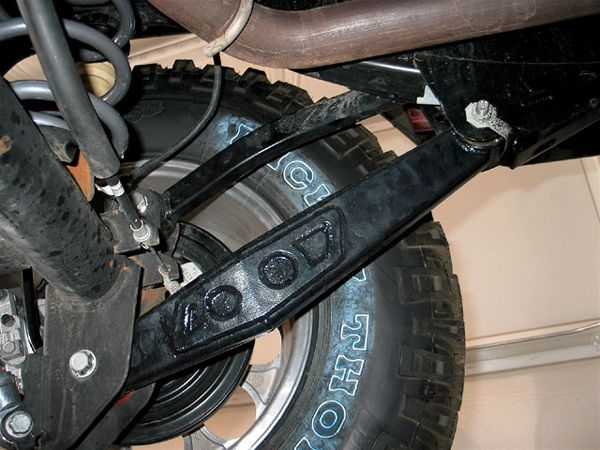
Pro Comp
Geared toward the mass market, the Pro Comp system offers up bread-and-butter simplicity with added touches like adjustable track bars and upper links and relocation brackets where needed.
On the rack: The boxed and plated fixed-length control arms are plenty beefy, and although we don't really like the potential for squeaking the poly bushings on the axle ends can afford, they're simple and easy to deal with. Frame ends feature spherical bushings. Adjustable upper control arms and eccentric cam bolts allow pinion angle changes to work with the factory JK CV driveshafts and all components are powdercoated, not painted.
On the street: We felt twitchier than a meth head on a five-day bindle. The steering didn't inspire confidence, with noticeable bumpsteer, lots of wandering and unwanted feedback to the steering wheel, and subpar responsiveness. There was some body lean in corners, but the optional MX-6 shocks could probably be turned up to counter that.
Over the high-speed dirt road: In stark contrast with its on-road handling, we found the suspension could handle relatively large stuff with little drama off-road. We noted some rear axle chatter and drift when taking high-speed corners and a noticeable top-heavy feel, but nothing sneaked up on us and took us by surprise. The ESP came on once or twice during our testing, but that was a product of our pushing the Jeep hard and not any inherent trait of the suspension.
In the rocks: We noted a lot of bushing squeak, and the Jeep seemed to lift a front tire quite readily. Rear flex was just average. Taking this Jeep in the rocks wasn't a pleasant experience and was downright scary in a few places where others easily walked through. It was very tippy when crossed up and proved to be the only suspension we backed out of hard lines for fear of rolling.
Over the whoops: By the last day of whoops testing, the bushings were singing a song. Regardless, aside from an overall vague steering feel, we found the suspension delivered a controllable and comfortable package. Not a race car, but definitely capable and up toward the front of the pack in the hard whoops.
Bottom line: It's a bread-and-butter lift for that look with big tires and off-road excursions. Leave the rocks for others.
Rock Krawler
One of the only other suspension manufacturers to drastically alter the factory JK geometry, the three-link rear is supposed to limit or do away with binding as the rear axle articulates.
On the rack: It's the only suspension with a dropped pitman arm, and it's also used in conjunction with a raised track bar. The links are large and beefy with spherical joints at the axles and adjustability on both ends. The upper third-link mount welds on between two frame crossmembers, and you need to weld the axle truss to the rear axlehousing. We liked the unique threaded adjustable bumpstops and the overall quality of the components.
On the street: The ride was slightly stiff and chattery, and you know you're driving a modified suspension. There's little to none of the stock handling and feel on the road. We noted a good amount of body lean and head toss when pushed into corners. The rear is a little floaty and not as sure-footed as most of those with the stock geometry.
Over the high-speed dirt road: We noted no bumpsteer and only very minor play in the steering, but the rear felt loose. We were also able to easily break the rearend out and get the ESP to intrusively step in. There's a definite top-heavy feel, and even though the ride quality is soft and comfortable through the worst of it, it's not a suspension we'd choose to push hard here.
In the rocks: The suspension was quiet as a mouse with, jaw-dropping flex from the front and rear. There was a little more steering effort required to turn through obstacles as compared with other suspensions, but as long as the rig was rolling, there were no problems. We had no stability issues whether climbing, off-camber, or dropping off stuff. This suspension really lives up to its name.
Over the whoops: Deviation from the factory geometry doesn't seem to deliver good results, as evidenced by our test rig's spooky and unstable hop through the whoops. The rear gets light and jacks to the side opposite of where the steering input is given. Turn left, and the rear jacks right-and so on. The steering was also all over the place, with the front and rear fighting each other for the right line. They want to go in opposite directions.
Bottom line: This is truly a Rock Krawler.
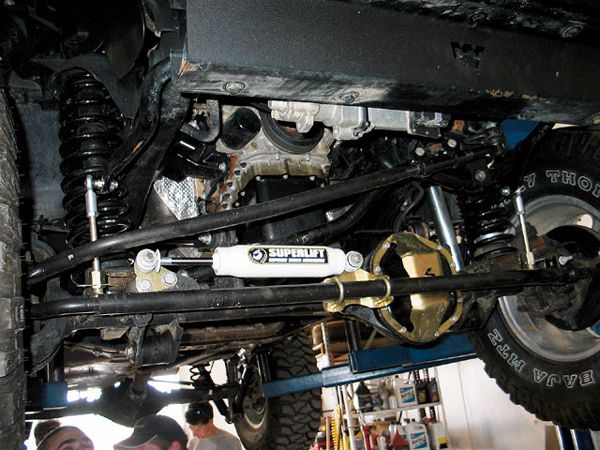
Superlift/Black Diamond
Of all the shiny new Jeeps we tested, the Superlift stood out as the lone example that looked like it had taken a trip through a coffee mill. We appreciate the fact that the company beats its vehicles like a wife on a Lifetime movie of the week.
On the rack: The suspension is 100 percent bolt-on and is comprised of heavy-duty components. Rubber frame and poly axle ends on the control arms keep quiet thanks to Rockrunner swivel links that prevent bushing bind. The kit keeps the factory driveshafts and steering and employs cam bolts to adjust the track bars. It's a simple yet well-addressed system that covers all the bases.
On the street: We appreciated the smooth and stable feel behind the wheel. Steering inputs were crisp and confident, and the front and rear seemed to work in harmony. We noted no driveshaft noises or vibes. Overall, this would be the suspension we'd want on something an inexperienced person would be driving.
Over the high-speed dirt road: We noticed the front doesn't bite and dig, but even with a little less responsiveness in the steering, we were able to hoof it at seriously high speeds. The rear would get a little loose, but in a controlled manner. We'd like a little more shock rebound for this type of driving, but comfort only really suffered during heavy hits. It was very forgiving and not mentally draining.
In the rocks: We were lifting front tires to the point that we thought the sway bar was still connected. It wasn't. The front shocks seemed to limit droop. Rear flex was on par with the others, and we found the ride to be very smooth with little head toss-you don't get bounced around all over the place. Stability coming down stuff, at angles and climbing, was a dead heat with the best of the rest. However, the need for more front articulation places it in the middle of pack for us overall.
Over the whoops: Halfway through testing, the Bilstein 5100s on the Jeep had totally faded. After a cool-down period, they were better, but still hampered the testing. Although there was a lot of bumpstop slapping, we heard no bad noises from the undercarriage and had little trouble controlling the vehicle as hard as the shocks would allow us to push it. We should note, to our surprise, the vehicles with Pro Comp MX-6 shocks didn't experience half the shock fade as those with the 5100s. It surprised us.
Bottom line: It's an everyday workhorse, daily driver, tough-as-nails system with very few drawbacks.
TeraFlex
Lots of shop owners we know say they carry TeraFlex suspensions because they have fewer call-back problems after installation compared with others. Indeed, to us, the suspension seems simple, complete, and well built.
On the rack: The most complex part of the install should be adjusting the control-arm length, which isn't too hard. The bolt-on kit includes track-bar brackets, bumpstops, brake-line relocation brackets, and strives to maintain as much of the factory JK steering and suspension geometry as possible. The components are well built and durably powdercoated. Control-arm bushing material is rubber on the frame for isolation and spherical ends at the axles for flex.
On the street: The simple twin-tube shocks transferred small bumps and irregularities to the cabin, and we noted the slightest hint of rear driveshaft tickle from the factory shaft. We noted no bumpsteer or ride-quality quirks, but there was a bit of play in the steering and a moderately unstable feel from the front and rear would make emergency maneuvers less than fun.
Over the high-speed dirt road: The spring firmness is middle of the road, which strikes a nice balance. We did get a lot of ESP activity, but we were also pushing the vehicle rather hard. Leaving the factory steering geometry worked because we noted zero bumpsteer no matter how hard we hit stuff.
In the rocks: There was some popping and clanging from the front as the coils unseated and hit the buckets. The shocks were also a little too stiff for comfort and to combat head toss, but otherwise, there were no surprises. Coming down big stuff, off-camber, climbing, steering, and flex were all enjoyable. Some higher-end shocks would make this an absolutely pleasant package in heavy rocks.
Over the whoops: We never thought a twin-tube shock could deliver such a high-performance ride, but other than a little bumpstop slapping and feeling the shocks top out as the axles dropped, it was a really fun time in the whoops. We experienced no bumpsteer, no noises, and enjoyed a rather smooth ride. There was no scary body lean, and the Jeep proved to deliver a well-balanced package of spring rate, shock valving, and control.
Bottom line: It's a great all-around bang for your buck.
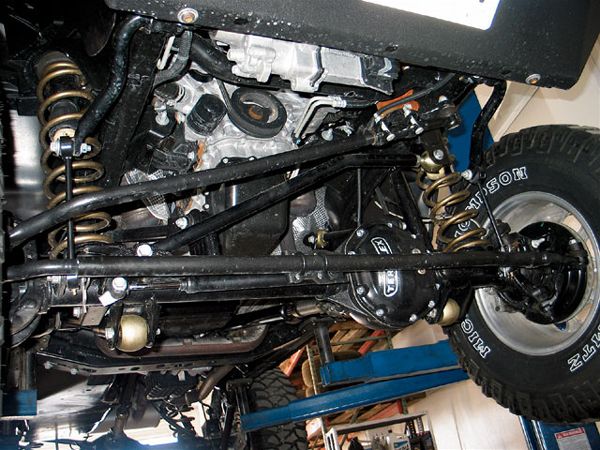
Trailmaster
With its dirt-simple design, the Trailmaster will assuredly appeal to the do-it-yourself driveway installer who wants to slap his lift on over the weekend and drive to work on Monday on new 33s or 35s.
On the rack: All of the components are nicely powdercoated. The suspension is extremely simple. The control arms are fixed length and sport poly bushings. The stock steering and driveshafts are retained, and a nice set of coils with lots of thin windings are used instead of a heavier coil with fewer windings. We don't like the track bars because the bends are unnecessarily angled, ugly, and not reinforced.
On the street: We were pretty blown away with the factory-like ride on the road portion. Basically, if you've driven a stock JK, you know how this suspension drives. We had zero issues, quirks, or surprises.
Over the high-speed dirt road: We were hoping for the same stability and predictability as on the street, but we found the rearend a bit chattery and the steering somewhat vague for our liking on this terrain. The ride was a little too soft in the rear and mildly too stiff in the front.
In the rocks: We didn't drive this one in the rocks because one of the lower front control-arm links snapped where they're bent for tire clearance. Clearly, some heavier wall tubing is needed or, at the very least, some reinforcing at the bend.
Over the whoops: With a replacement control arm, we found an overly stiff ride that bucked in the rear. Steering was a bit wallowy when pushed hard, and we just didn't find confidence in the suspension.
Bottom line: This kit is very user-friendly for the do-it-yourselfer who wants the look of a lift and bigger tires with no handling drawbacks on-road.








